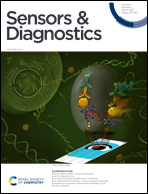Recent progress in nanozyme-based sensors for ion detection: strategies, trends, and challenges
Abstract
In situ real-time monitoring of pollution sources is one of the most effective means to control and prevent toxic ions from harming the environment and human health. To this end, it is critical to develop rapid, cost-effective, and user-friendly methods for ion detection. Nanozymes, like natural enzymes, can efficiently catalyze substrate reactions with the advantages of simple synthesis, low cost, long storage time, and excellent environmental stability. Importantly, certain ions can regulate the properties of nanozymes or affect their catalytic systems. Therefore, nanozymes have found increasing use in ion sensing. To highlight the latest advances made in this interesting area, here we focused on summarizing the progress in nanozyme-based ion assays developed mainly in the past three years. Emphatically, current trends and future challenges as well as potential solutions were discussed in detail. Our review will provide some guides to rationally design and develop nanozymes for biochemical sensing, especially for toxic ion detection and control. Also, it is expected to attract more interest in this promising field.



 Please wait while we load your content...
Please wait while we load your content...